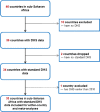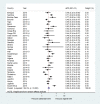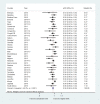Impact of caesarean section on breastfeeding indicators: within-country and meta-analyses of nationally representative data from 33 countries in sub-Saharan Africa
- PMID: 31488470
- PMCID: PMC6731935
- DOI: 10.1136/bmjopen-2018-027497
Impact of caesarean section on breastfeeding indicators: within-country and meta-analyses of nationally representative data from 33 countries in sub-Saharan Africa
Abstract
Objective: To examine the impact of caesarean section on breastfeeding indicators-early initiation of breastfeeding, exclusive breastfeeding under 6 months and children ever breastfed (at least once)-in sub-Saharan Africa.
Design: Secondary analysis of Demographic and Health Surveys (DHS).
Setting: Thirty-three low-income and middle-income countries with a survey conducted between 2010 and 2017/2018.
Participants: Women aged 15-49 years with a singleton live last birth during the 2 years preceding the survey.
Main outcome measures: We analysed the DHS data to examine the impact of caesarean section on breastfeeding indicators using the modified Poisson regression models for each country adjusted for potential confounders. For each breastfeeding indicator, the within-country adjusted prevalence ratios (aPR) were pooled in random-effects meta-analysis.
Results: The within-country analyses showed, compared with vaginal birth, caesarean section was associated with aPR for early initiation of breastfeeding that ranged from 0.24 (95% CI 0.17 to 0.33) in Tanzania to 0.89 (95% CI 0.78 to 1.00) in South Africa. The aPR for exclusive breastfeeding under 6 months ranged from 0.58 (95% CI 0.34 to 0.98) in Angola to 1.93 (95% CI 0.46 to 8.10) in Cote d'Ivoire, while the aPR for children ever breastfed ranged from 0.91 (95% CI 0.82 to 1.02) in Gabon to 1.02 (95% CI 0.99 to 1.04) in Gambia. The meta-analysis showed caesarean section was associated with a 46% lower prevalence of early initiation of breastfeeding (pooled aPR, 0.54 (95% CI 0.48 to 0.60)). However, meta-analysis indicated little association with exclusive breastfeeding under 6 months (pooled aPR, 0.94 (95% CI 0.88 to 1.01)) and children ever breastfed (pooled aPR, 0.98 (95% CI 0.98 to 0.99)) among caesarean versus vaginally born children.
Conclusions: Caesarean section had a negative influence on early initiation of breastfeeding but showed little difference in exclusive breastfeeding under 6 months and children ever breastfed in sub-Saharan Africa.
Keywords: epidemiology; maternal medicine; paediatrics; public health.
© Author(s) (or their employer(s)) 2019. Re-use permitted under CC BY-NC. No commercial re-use. See rights and permissions. Published by BMJ.
Conflict of interest statement
Competing interests: None declared.
Figures




References
-
- Horta BL, Victora CG, World Health Organization . Short-Term effects of breastfeeding: a systematic review on the benefits of breastfeeding on diarrhoea and pneumonia mortality, 2013. Available: http://www.who.int/iris/handle/10665/95585
Publication types
MeSH terms
LinkOut - more resources
Full Text Sources
Medical
Miscellaneous
